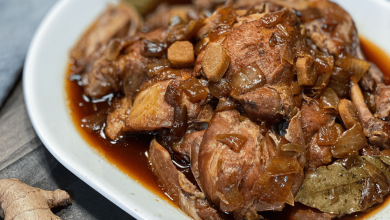🍲 Asian Soup Stock: A Flavorful Journey 🍜
Asian soup stocks are the heart and soul of countless delectable dishes in Asian cuisine. They serve as the foundation for various soups, stews, and sauces, providing a rich and aromatic base that infuses flavors into the dishes. Let’s embark on a flavorful journey into the world of Asian soup stock!
📜 History:
The history of Asian soup stocks dates back centuries, and their recipes have evolved across different regions and cultures. Each Asian country has its own unique traditions and ingredients. In China, for instance, there’s a long history of using aromatic ingredients like ginger, scallions, and star anise. In Japan, dashi, made from fish and seaweed, is the cornerstone of many dishes. The diversity of Asian cuisine has led to a wide range of stock variations.
🧊 Components:
Asian soup stocks typically consist of a few common components:
- Water: The base of any stock.
- Aromatics: These can include garlic, ginger, scallions, lemongrass, and herbs. They add depth and aroma to the stock.
- Protein: Depending on the type of stock, you might use chicken, pork, beef, seafood, or even vegetarian options.
- Seasonings: Soy sauce, miso, fish sauce, and salt are used to season the stock and add complexity.
- Optional Ingredients: Some stocks may include dried seafood (like dried shrimp or bonito flakes), vegetables (shiitake mushrooms, radish), and other seasonings to enhance the flavor.
👩🍳 Preparation Steps:
The steps to prepare Asian soup stock can vary based on the specific dish and region, but here’s a general guideline:
-
Prepare Aromatics: Start by chopping or bruising your aromatics (garlic, ginger, scallions, etc.) to release their flavors.
-
Bring Water to a Simmer: In a large pot, bring water to a simmer. The amount of water depends on your recipe. As a rule of thumb, use about 4-6 cups for a small batch.
-
Add Protein: If making a meat-based stock, add the protein (chicken, pork, beef) and simmer. Remove any impurities that rise to the surface.
-
Aromatics and Seasonings: Add the prepared aromatics, seasonings, and any optional ingredients. Simmer gently to infuse the flavors.
-
Simmer and Strain: Simmer for a specific duration, typically 1-4 hours, depending on the stock type. After simmering, strain the stock to remove solids.
-
Cool and Store: Allow the stock to cool, then store it in airtight containers. It can be refrigerated for a few days or frozen for several months.
🕰️ Time Needed:
The time required to prepare Asian soup stock varies depending on the type and complexity. Simple vegetable stocks may take around 1-2 hours, while more complex meat-based stocks, like a rich ramen broth or a hearty Pho, can take up to 4-6 hours. The long cooking times are essential for extracting maximum flavor from the ingredients.
Asian soup stocks are a labor of love, and they’re well worth the effort for the depth of flavor they bring to dishes. Whether you’re making a comforting bowl of miso soup, a steaming hot pot, or a savory stir-fry, the stock is the secret ingredient that makes Asian cuisine truly special. 🍲🌟
Certainly, here’s some nutrition and health information related to Asian soup stock:
Nutrition Facts:
The nutritional content of Asian soup stock can vary significantly depending on the specific ingredients and recipe. However, here’s a general idea of what you might find in a typical serving (approximately 1 cup) of a basic Asian chicken or vegetable stock:
- Calories: About 10-20 calories per cup.
- Protein: Minimal, around 1-2 grams per cup.
- Carbohydrates: Negligible carbs, usually less than 1 gram per cup.
- Fat: Minimal, usually less than 1 gram per cup.
- Sodium: The sodium content can vary, but it’s typically on the lower side if homemade and not excessively salted. Commercial bouillon cubes or stocks tend to have higher sodium levels.
Health Information:
-
Hydration: Asian soup stocks, being primarily water-based, can help with hydration. However, be cautious about sodium levels, especially in store-bought stocks, as excessive sodium intake can lead to high blood pressure and other health issues.
-
Low in Calories and Fat: Homemade Asian stocks are generally low in calories and fat, making them a healthy addition to your diet.
-
Nutrient Absorption: The long cooking process for some stocks, like bone broths, may release nutrients such as collagen and minerals like calcium, magnesium, and phosphorus. These nutrients can be beneficial for bone and joint health.
-
Aromatics and Health Benefits: Aromatics like ginger and garlic used in Asian stocks may have various health benefits. Ginger, for example, is known for its anti-inflammatory properties, and garlic is associated with heart health and immune support.
-
Watch Sodium Levels: Be cautious about the sodium content, especially if you have high blood pressure or are on a low-sodium diet. You can reduce sodium by using low-sodium soy sauce or salt alternatives.
-
Customization: Making your own stock allows you to control the ingredients, which can be especially beneficial if you have dietary restrictions or food allergies.
Keep in mind that the nutritional content and health impact of Asian soup stocks can vary widely based on how they are prepared and what specific ingredients are used. If you’re seeking precise nutritional information for a particular recipe or product, it’s a good idea to consult the packaging or use a nutritional calculator for homemade stocks.








